How to Change Your Wi-Fi Password and Name
Learn how to change your Wi-Fi password and name easily to keep your network secure.
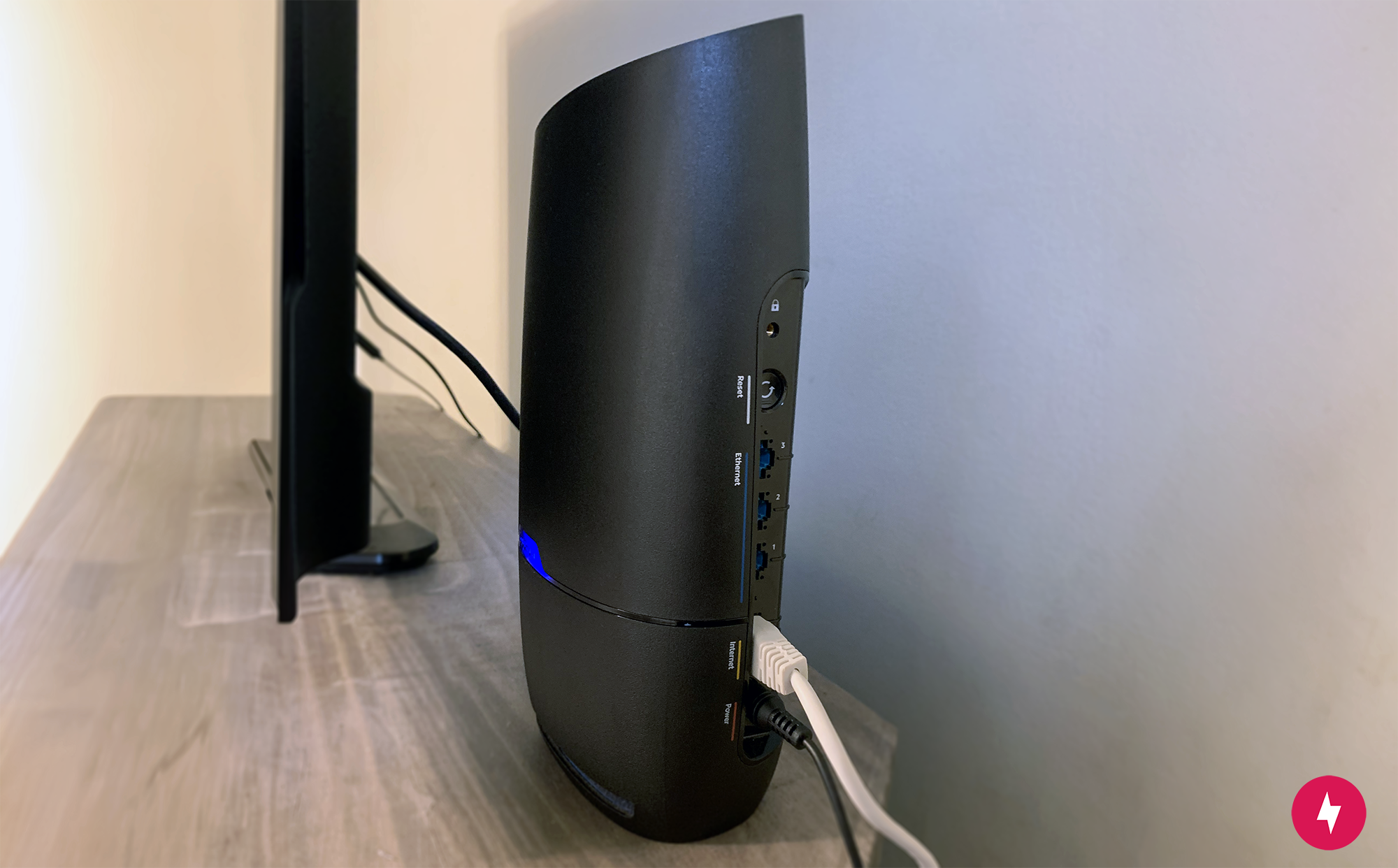
- Before changing your Wi-Fi password, you need to know your router’s IP address, which is usually 192.168.1.1 or 192.168.0.1.
- Many internet providers have interfaces where you can change your password easily.
- Experts advise changing your network name from time to time, along with your password, to maintain the best security.
Whether you’re moving into a new house or just want to increase your home’s cybersecurity, the time has come to update your Wi-Fi settings. Changing your Wi-Fi password and name helps keep your home network secure from strangers and hackers. You want to ensure that only authorized people can log into your Wi-Fi to avoid unauthorized access to your personal information.
If you have little experience updating this information, the process can be challenging. I moved no less than five times during the last decade and found navigating all the Wi-Fi changes on top of the moving process to be incredibly cumbersome. Every device has different steps, so it’s not always cut and dry. Avoid making mistakes that lock you out of your network (instead of others) by following these comprehensive steps to update your Wi-Fi credentials effectively, no matter which device you’re using.
Our Video on How to Change Your Wi-Fi Password
No time to read the rest of the article? Say less! Watch our video below for a visual representation of how to change your Wi-Fi password and name:
How to Find Your Router’s IP Address
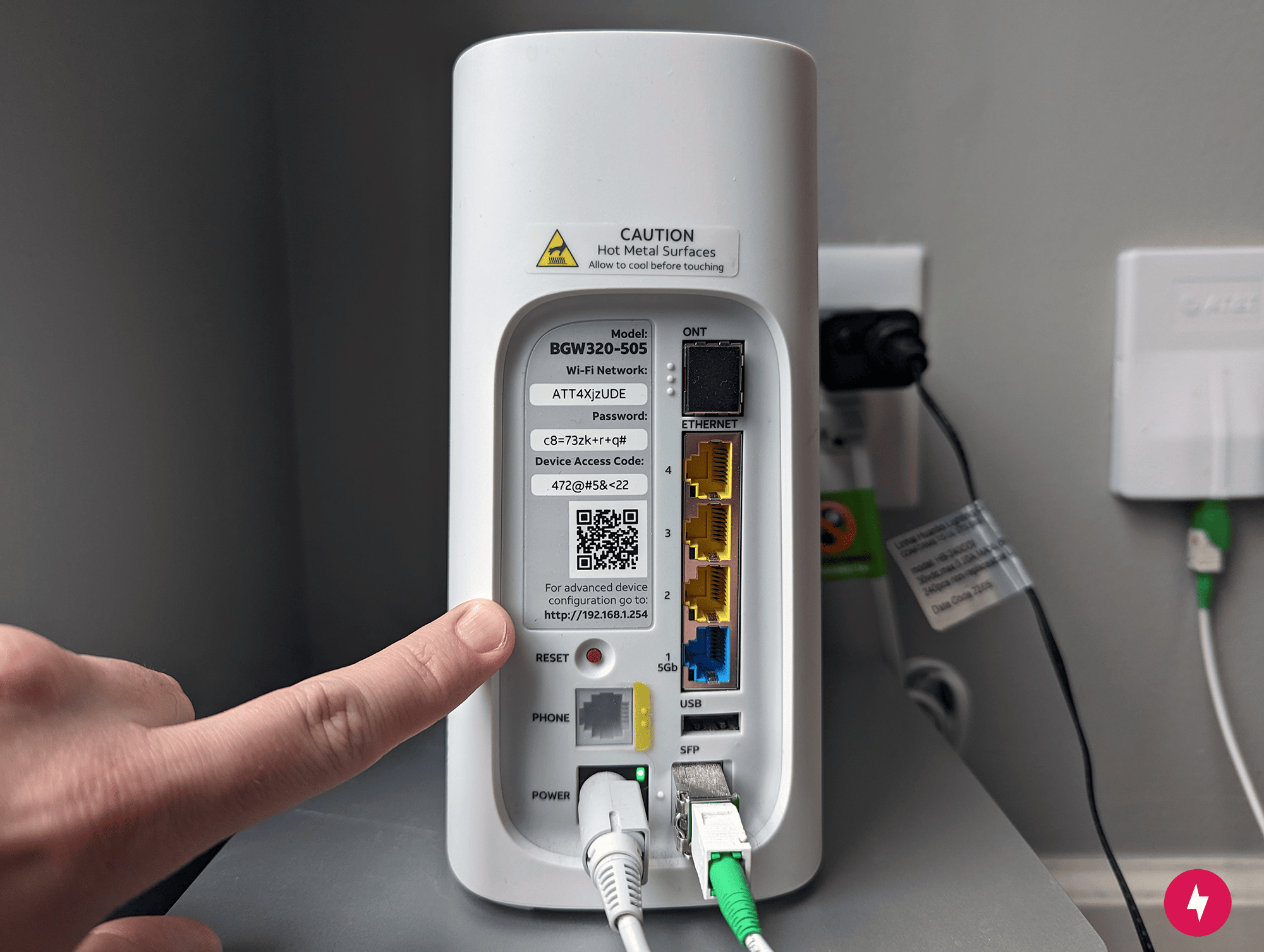
The first step in changing your Wi-Fi password is locating your router’s IP address. You’ll then enter this information into your browser to access your Wi-Fi settings. Usually, home network IP addresses start with 192.168. Your router will have a similar sequence. Routers commonly have either the default IP address 192.168.1.1 or 192.168.0.1, but this scenario isn’t always the case (as evidenced by the 192.168.1.254 address for AT&T’s router shown above).
You can manually search for your router’s IP address by checking the device itself. Typically, the side or back of the router displays this information, as was the case for our Editor’s AT&T router in the above photo. However, my Spectrum router didn’t have this information printed on the device, so I had to use another method to find its IP address. Alternatively, you can reference the router user manual to locate the IP address.
You can also find the IP address wirelessly using either a mobile device or your home computer. While I have an iPhone and Windows laptop, you may need to find your router’s IP address for Mac or Android devices. We cover each of these devices and operating systems in the steps below:
How to Find Your Router’s IP Address on iPhone
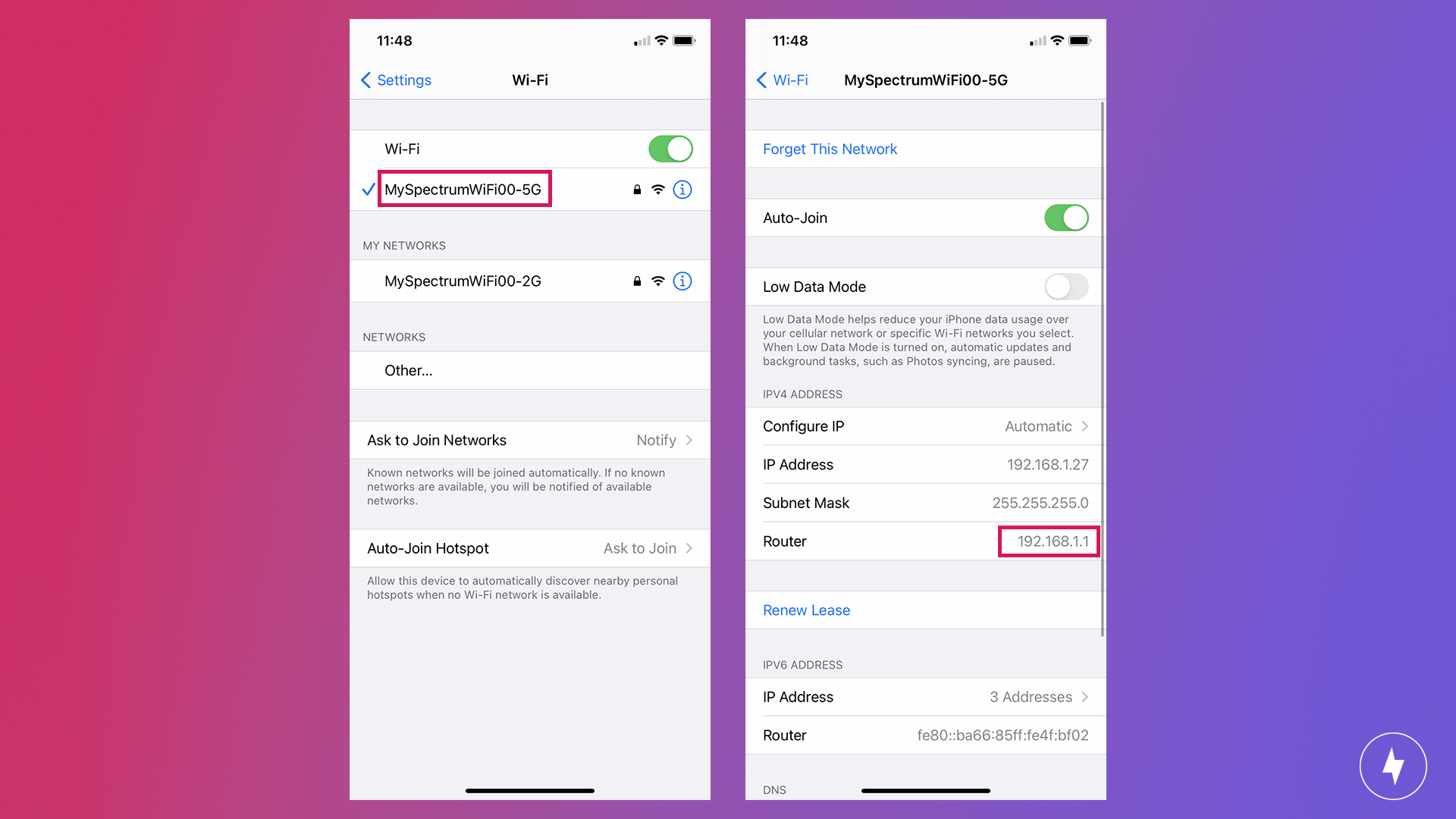
- Go to Settings.
- Tap Wi-Fi.
- Tap on your network’s name.
- Write down the number displayed next to Router.
How to Find Your Router’s IP Address on Windows 10

- Select Start, and navigate to Settings.
- Click Network & Internet.
- Click Properties underneath your active Wi-Fi network.
- Scroll down to Properties, and search for IPv4 DNS servers. The number next to this section is your router’s IP address.
How to Find Your Router’s IP Address on Mac
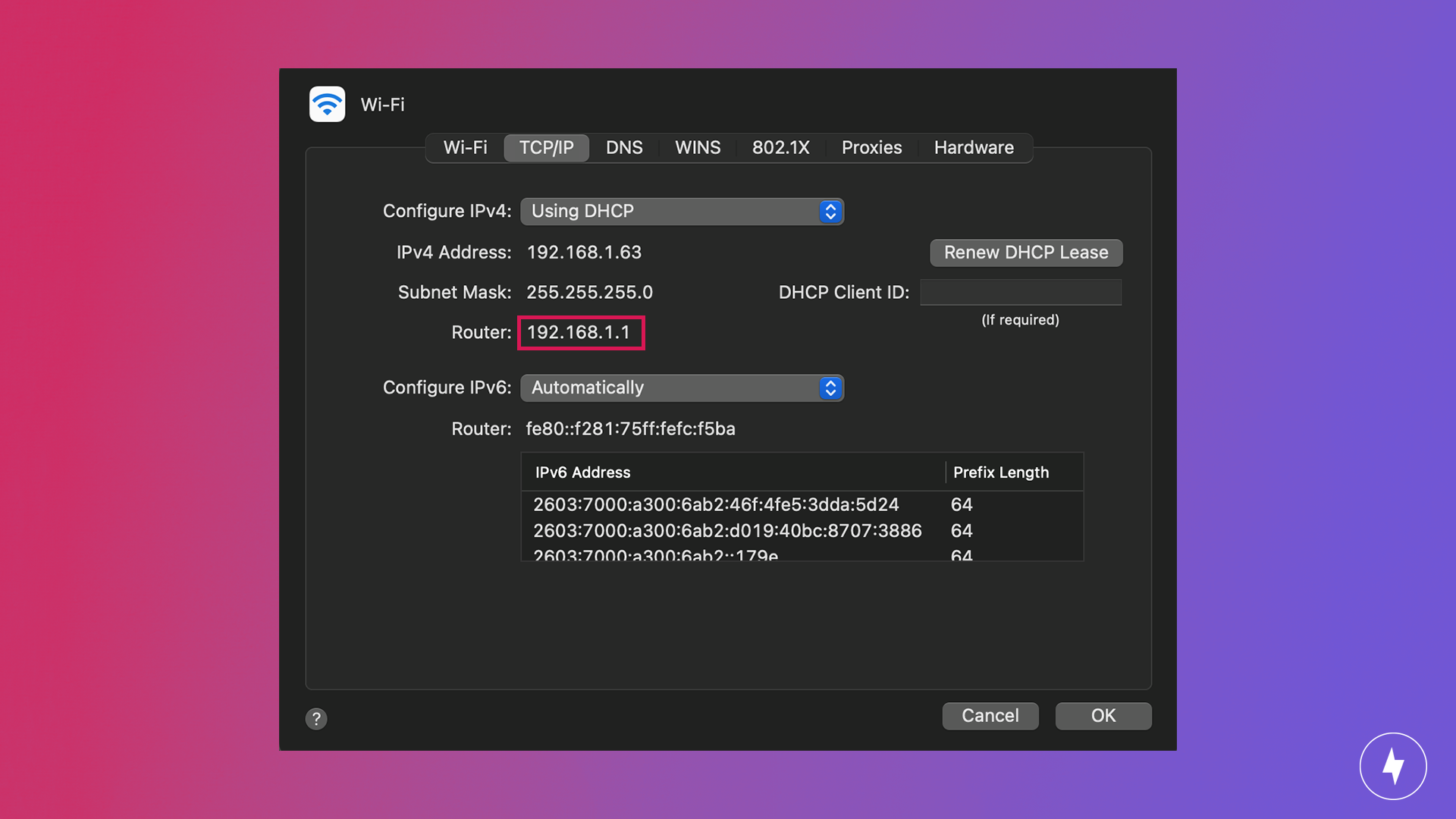
- Click the Apple icon.
- Select System Preferences.
- Choose Network.
- Choose your network from the list, and click Advanced at the bottom right.
- Select TCP/IP, and write down the number next to Router.
Wired or Wireless? Finding your router’s IP Address and changing your Wi-Fi password can be done wirelessly or via an Ethernet cable. I preferred to utilize the wireless method, but you can connect an Ethernet cable between your computer and router to access your Wi-Fi settings.
How to Change Your Wi-Fi Password
Now that you know your router’s IP address, you can move forward with changing your Wi-Fi password. The username and password for routers tend to be generic, such as “admin” or “password.” Whether you have a Netgear, Linksys, or another popular router brand, you can usually find this information on the back or side of the router. If you can’t locate the information there, check the user’s manual or the router manufacturer’s website.
How to Change Your Wi-Fi Password in a Web Browser
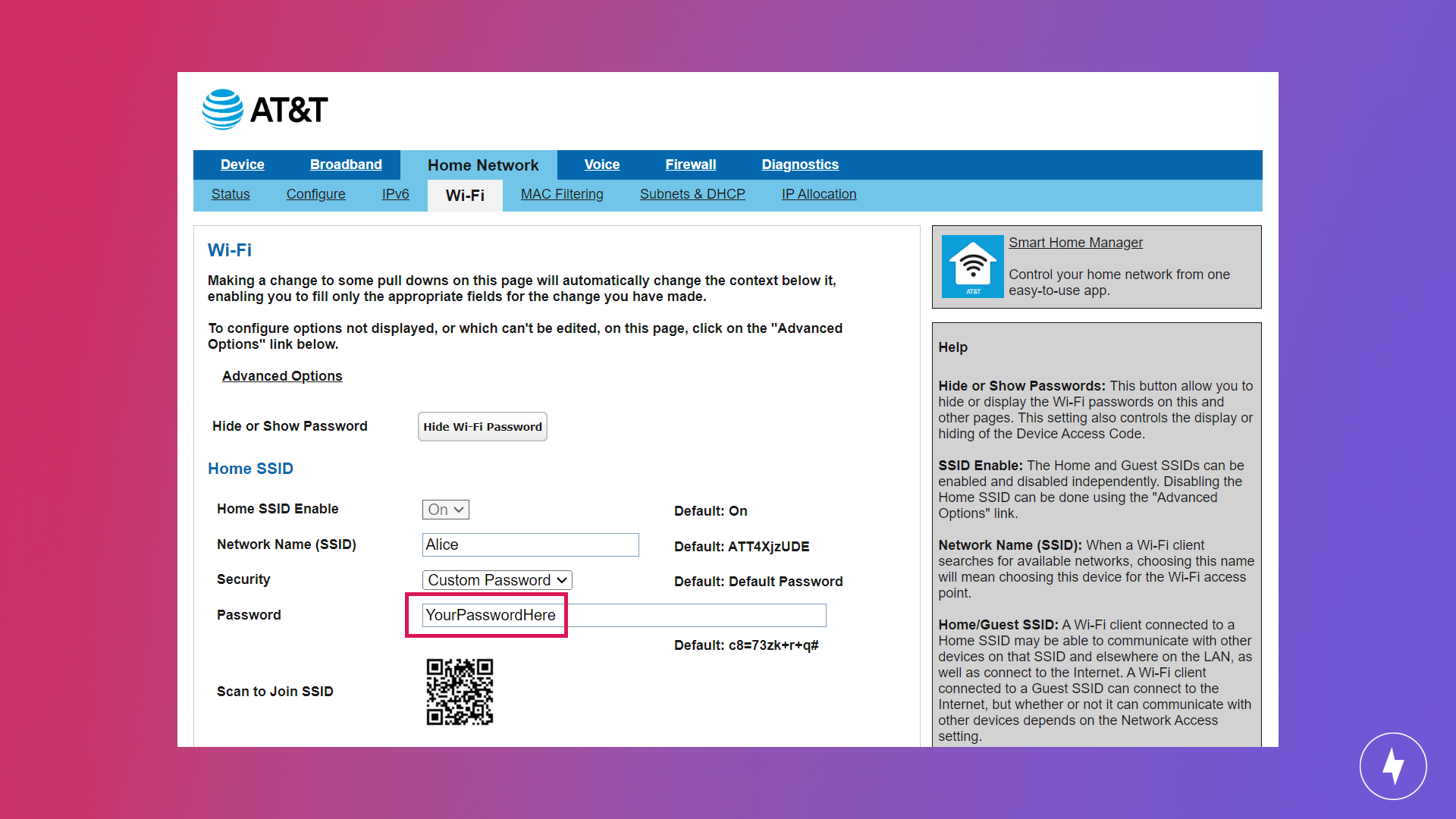
- Open an internet browser, such as Chrome or Firefox, on your computer.
- Enter your router’s IP address in the address bar.
- Enter the router login credentials.
- Click the section for Wi-Fi (which will vary depending on the router).
- Insert your new Wi-Fi password
- Save your settings, and reboot the router.
How to Change Your Wi-Fi Password in a Spectrum Router
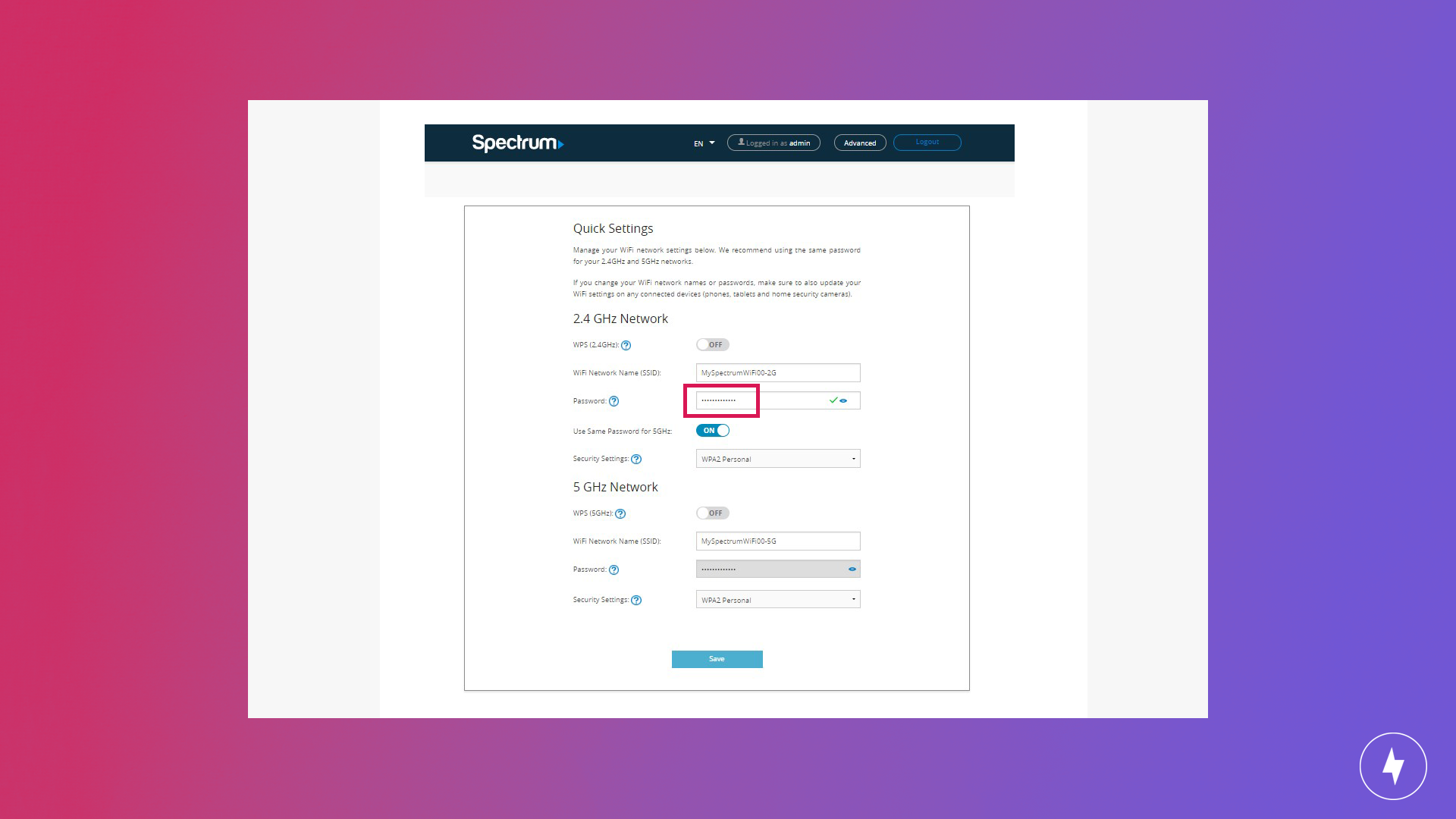
- Enter your router’s IP address in a web browser.
- Enter the Spectrum router login credentials.
- Locate the section labeled Password beneath your network name.
- Enter a strong Wi-Fi password.
- Select Save to confirm the changes (which will take effect immediately).
Wi-Fi Password Tip: Use a strong password that consists of a mix of uppercase letters, lowercase letters, numbers, and symbols. Avoid using identifiable information such as names or birth dates. Stay away from simple words, such as “password,” or common sequences, such as “12345.” Your Wi-Fi password should be independent and not a duplicate of other passwords you use across the internet.
Once you change your password, your router will disconnect from your devices. You must reconnect all devices with the updated password and share the Wi-Fi information with your household.
How to Pick Wi-Fi Network Protection
In most cases, you have the option of choosing a wireless security protocol. There are four wireless encryption types:
- Wired Equivalent Privacy (WEP)
- Wi-Fi Protected Access (WPA)
- WPA2
- WPA3
The most secure Wi-Fi access point is WPA3, but this option isn’t supported on all networks. The next best option is WPA2, which is the most commonly used security protocol. WEP and WPA are both considered outdated access points. Using either of these options could open your network to security threats.
How to Change Your Wi-Fi Name (SSID)
In addition to changing your Wi-Fi password, you can modify other information on your router, including your Wi-Fi name, also known as Service Set Identifier (SSID). The default SSID features a generic name, and you can change it to a name that’s easy to identify. I personally tend to name my Wi-Fi networks after characters from “Alice in Wonderland,” but you can choose any name you want. Just make sure your Wi-Fi network name doesn’t have any personally identifying information.
Modify your SSID in the same location used when changing your Wi-Fi password. Here are the steps to accessing the settings and changing your Wi-Fi name:
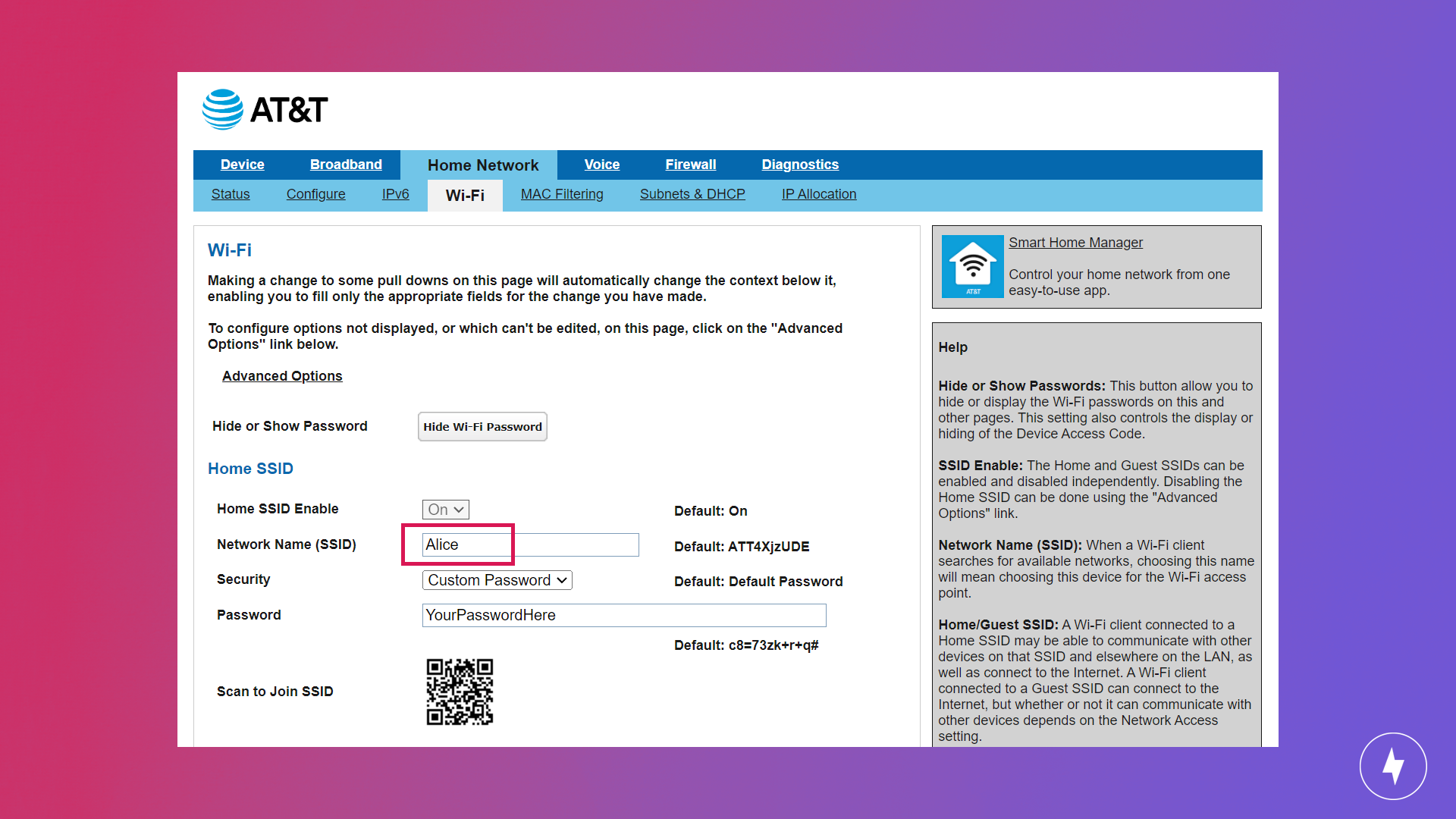
- Open your internet browser and enter your router’s IP address into the address field.
- Login using your router username and password.
- Locate the section labeled Network Name (SSID).
- Enter a new network name.
- Select Save to confirm the changes (you’ll notice the change immediately).
What’s in a Wi-Fi Name? Avoid using a moniker, surname, or street address in your SSID. You do not want your network to feature identifiable information that could put you at risk of being hacked. You don’t need to use a mix of uppercase letters, lowercase letters, numbers, and symbols as you do with a password. Instead, create an easily identifiable network name for you and your family to remember.
How to Change Your Wi-Fi via Apps
Many popular service providers, including AT&T, Spectrum, and Xfinity, make updating your Wi-Fi information simple with apps. For example, AT&T offers Smart Home Manager, an app that allows you to control your Wi-Fi settings from anywhere. I personally don’t like keeping too many apps on my phone, but internet provider apps make changing your Wi-Fi settings easy and flexible. No matter whether you are at work, on vacation, or elsewhere outside your home, you can modify your Wi-Fi network wherever. This feature comes in handy if your information risks becoming compromised or hacked.
How to Change Your AT&T Wi-Fi Settings in the App

- Navigate to the Smart Home Manager app.
- Tap the Wi-Fi button on the bottom bar.
- Tap the Manage Wi-Fi card.
- Select Edit next to the Wi-Fi name or password you wish to change.
- Clear the existing information by selecting X.
- Input a new name or strong password.
- Click Save to update your settings.
How to Change Your Xfinity Wi-Fi Settings in the App

- Navigate to the Xfinity App.
- Tap Connect.
- Choose your network.
- Tap View or Edit Wi-Fi Settings.
- Edit your Wi-Fi name and password.
- Tap Save.
How to Change Your Spectrum Wi-Fi Settings in the App

- Navigate to the My Spectrum App.
- Select Services from the menu at the bottom of the screen.
- Under Your Spectrum Network, choose the network you wish to edit.
- Click Edit Network Info and update your Wi-Fi name and password.
- Tap Save.
In addition to apps from internet service providers, most routers feature companion apps that allow you to change your Wi-Fi name and password. Each manufacturer will feature different steps for updating this information. The option to edit your Wi-Fi name and password will be prominently featured within the app’s settings section.
How to Modify Your Wireless Mesh Network
Wireless mesh networks feature wireless extenders that help improve connection quality for homes in dead zones or with several smart devices. A Wi-Fi mesh network has several SSIDs, whereas a traditional router has one SSID. Updating the information using either is very similar. Since eero is the most popular mesh Wi-Fi router model, let’s look at how to change your Wi-Fi settings using an eero device. I recently set up this device in my home and found the whole process incredibly user-friendly, so don’t let the advanced use of a mesh network frighten you.
How to Change Your eero Wi-Fi Settings

- Open your eero app on your mobile device.
- Click on Settings.
- Select the Wi-Fi configuration you wish to edit and update the information.
- Tap Save.
How to Test Your New Wi-Fi Settings
Once you’ve changed your Wi-Fi settings, you need to test the new credentials to ensure everything works properly. Use a device such as a smartphone or a computer and enter your updated information. Ensure you can connect and navigate online using the credentials.
After you save your Wi-Fi changes, your network won’t stay connected to other devices. You’ll need to reconnect anything previously connected to your Wi-Fi. For example, I have a smart refrigerator and washer, so I had to update the Wi-Fi settings for each to keep them connected. Here’s a list of devices you may need to reconnect in your home:
- Smart speakers
- Gaming consoles
- Security systems
- Smart TVs
- Smart fridges
- Other Wi-Fi-enabled devices in your home
How to Reset Your Wi-Fi Router

If you don’t have access to or have lost your router login credentials, Wi-Fi network name, or Wi-Fi password, you can reset your router to return the device to the factory settings. This feature is a useful fail-safe should any of your information become lost or compromised.
Here are the steps you need to take to reset a router:
- Press your router’s reset button. You’ll find the button located on the side or back of the router. While my Spectrum router had a full-sized button, many times you’ll need to use a small, thin object such as a paper clip or pin to press the button.
- You can connect to the router’s Wi-Fi network without a password following a reset. Follow the steps covered earlier to use your router’s IP address to enter the router settings on your internet browser.
- Use the default username and password for your router, which can be found on the side or back of your router. You can contact the router’s manufacturer to access the credentials if you don’t have this information.
- From here, you can proceed through the above steps to change your Wi-Fi information.